

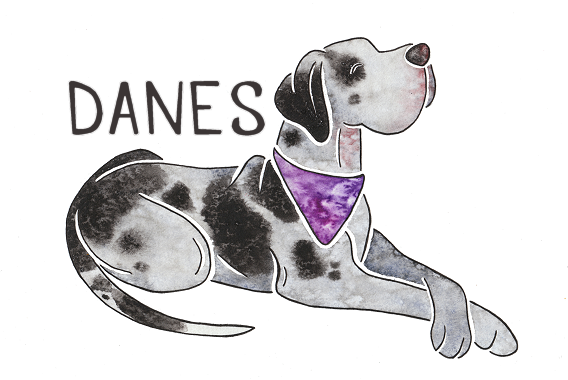
Colours and Patterns in the Great Dane
A full case study of a well-known breed with some surprising and unique coat patterns. Make sure to read the Breeding page before tackling this one!

Acceptable Colours
The acceptable colours in the Great Dane, according to the American Kennel Club standard, are:
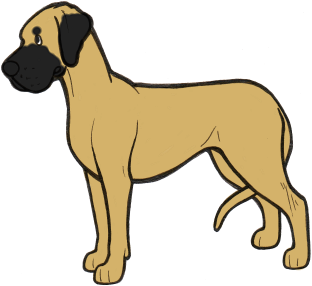
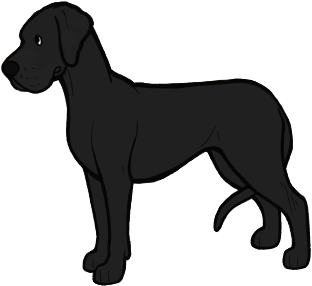
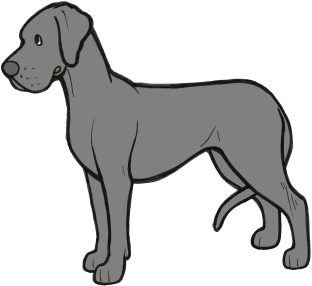
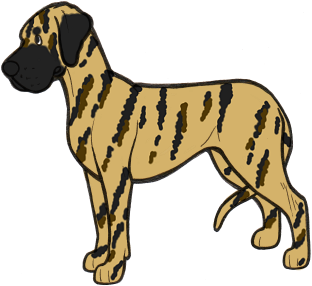
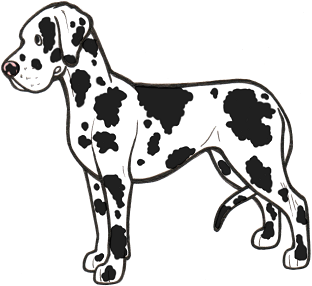
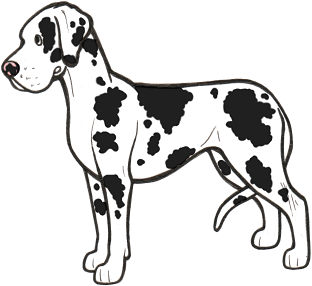
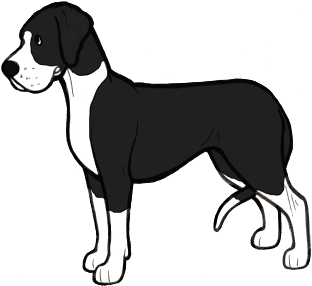
Fawn, which is clear sable (Ay) with a mask
Black
Blue, which is dilute black (dd)
Brindle, with a mask
Harlequin, which is modified merle
Harlequin mantle, which is as above but with irish spotting
Mantle (otherwise known as Boston), which is black with irish spotting (sisi)

That means that Great Danes carry the following alleles:
- A locus: Ay (sable)
- B locus: B (non-liver)
- C locus: ? Probably just C (normal expression of phaeomelanin)
- D locus: D (non-dilute), d (dilute)
- E locus: Em (mask)
- G locus: g (no greying)
- H locus: H (harlequin), h (non-harlequin)
- K locus: K (dominant black), kbr (brindle), k (allows expression of A locus)
- M locus: M (merle), m (non-merle)
- S locus: S (no white spotting), si (irish spotting)
- T locus: t (no ticking)
We don't need to take into account some of these locii when looking at Great Dane breeding, simply because there's only one allele they carry on that locus (their genotype is "fixed" at that locus), so all Danes will be homozygous for it. For example, all Danes are sable (AyAy), it's just some can't express it as the dominant black gene overrides sable. The locii in bold type above are the ones we do need to consider.

Other Colours
The Great Dane is unique in that a huge proportion of the possible colours it can occur in are not actually acceptable in the show ring. All of the following colours and patterns can be bred from crossing acceptable colours. In order to avoid breeding too many puppies that are unshowable, breeders tend to breed only certain colours together, for example breeding a black with a mantle is considered a "safe" breeding because it doesn't generally produce unshowable colour combinations (although it can sometimes result in incorrect white markings).
These are all of the other colours that can occur in the Great Dane, along with their genotypes. I have only included colours that can be bred from the accepted ones above. A dash (-) in the genotype means that it doesn't matter what that allele is because it won't change the phenotype (the way the dog looks). Put your mouse over the colour name for a picture example.
- Blue mantle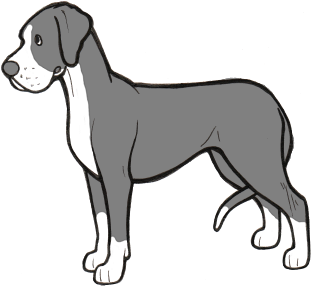
Blue mantle: dd/--/K-/mm/sisi
- Brindle mantle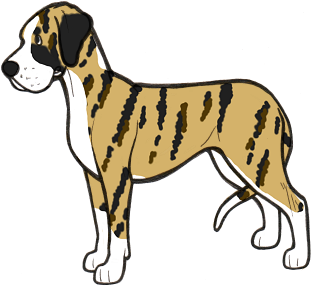
Brindle mantle: D-/--/kbr-/mm/sisi
- Blue brindle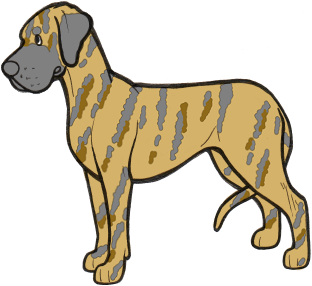
Blue brindle: dd/--/kbr-/mm/SS
- Blue brindle mantle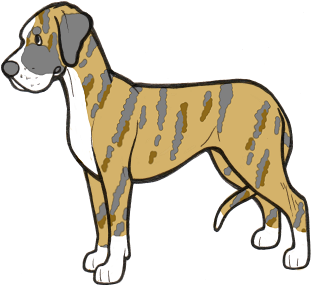
Blue brindle mantle: dd/--/kbr-/mm/sisi
- Fawn mantle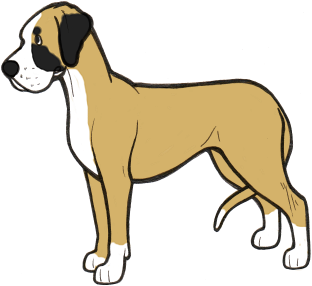
Fawn mantle: D-/--/kk/mm/sisi
- Blue fawn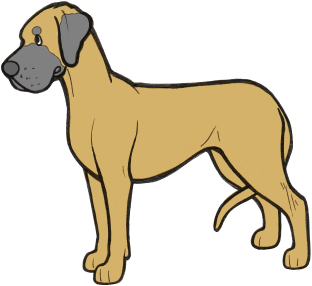
Blue fawn: dd/--/kk/mm/SS
- Blue fawn mantle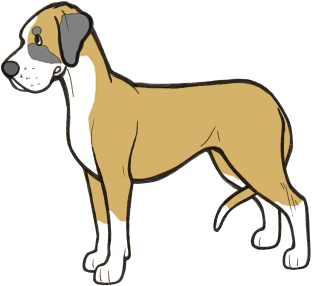
Blue fawn mantle: dd/--/kk/mm/sisi
- Merle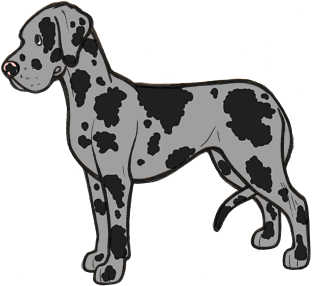
Merle: D-/hh/K-/Mm/SS
- Merle mantle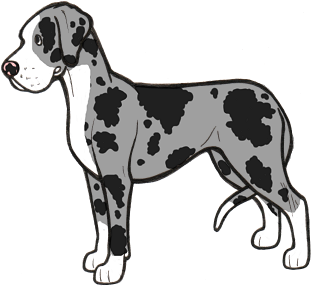
Merle mantle: D-/hh/K-/Mm/sisi
- Blue (dilute) merle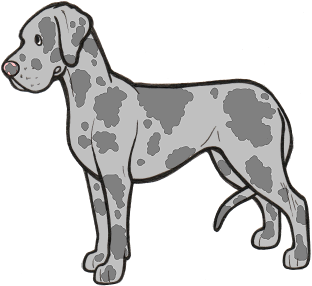
Blue (dilute) merle: dd/hh/K-/Mm/SS
- Blue (dilute) merle mantle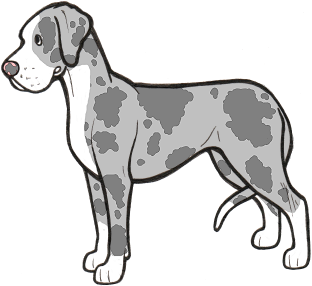
Blue (dilute) merle mantle: dd/hh/K-/Mm/sisi
- Brindle merle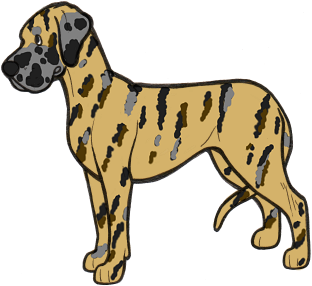
Brindle merle: D-/hh/kbr-/Mm/SS
- Brindle merle mantle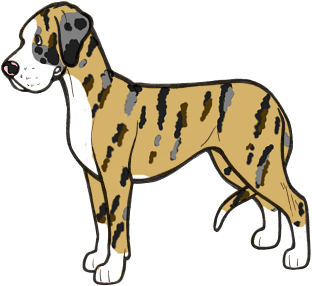
Brindle merle mantle: D-/hh/kbr-/Mm/sisi
- Blue brindle merle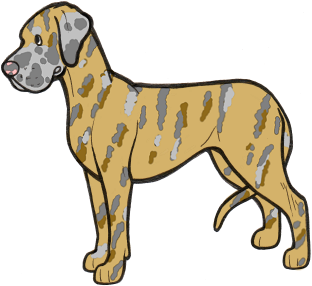
Blue brindle merle: dd/hh/kbr-/Mm/SS
- Blue brindle merle mantle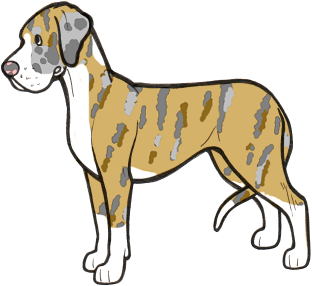
Blue brindle merle mantle: dd/hh/kbr-/Mm/sisi
- Fawn merle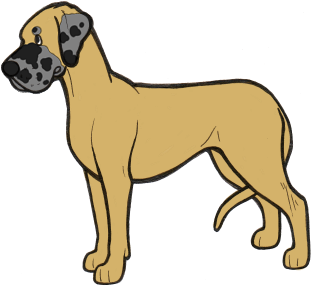
Fawn merle: D-/hh/kk/Mm/SS
- Fawn merle mantle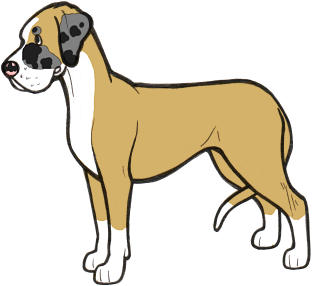
Fawn merle mantle: D-/hh/kk/Mm/sisi
- Blue fawn merle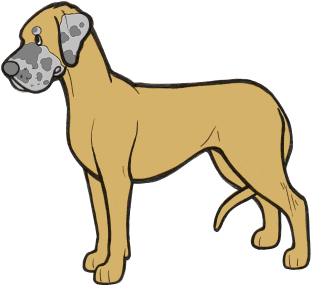
Blue fawn merle: dd/hh/kk/Mm/SS
- Blue fawn merle mantle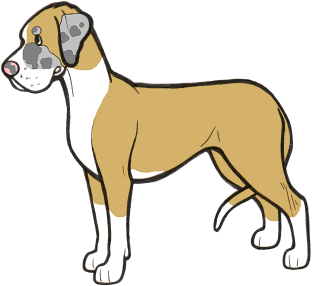
Blue fawn merle mantle: dd/hh/kk/Mm/sisi
- Blue harlequin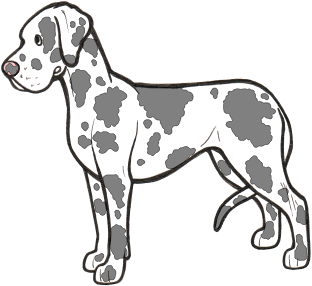
Blue harlequin: dd/Hh/K-/Mm/SS
- Blue harlequin mantle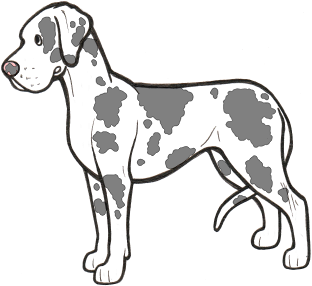
Blue harlequin mantle: dd/Hh/K-/Mm/sisi
- Fawn harlequin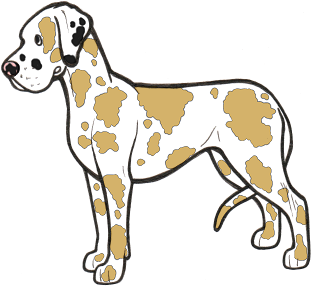
Fawn harlequin: D-/Hh/kk/Mm/SS
- Fawn harlequin mantle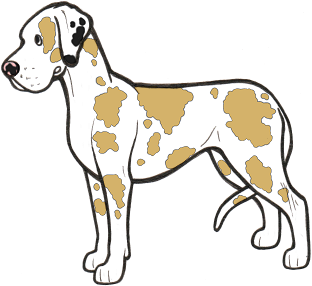
Fawn harlequin mantle: D-/Hh/kk/Mm/sisi
- Blue fawn harlequin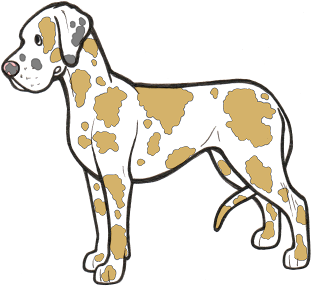
Blue fawn harlequin: dd/Hh/kk/Mm/SS
- Blue fawn harlequin mantle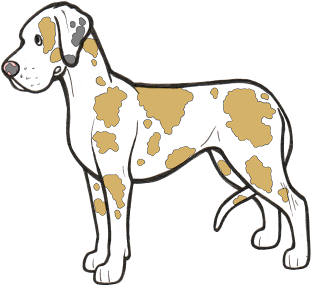
Blue fawn harlequin mantle: dd/Hh/kk/Mm/sisi
- Brindle harlequin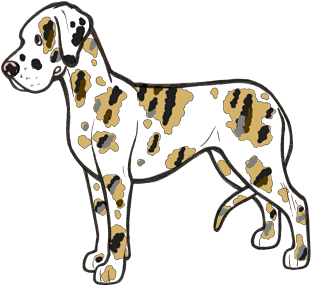
Brindle harlequin: D-/Hh/kbr-/Mm/SS
- Brindle harlequin mantle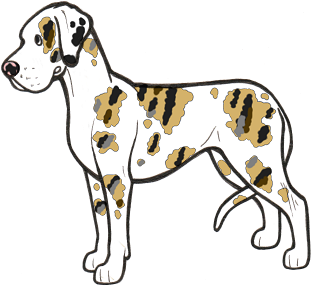
Brindle harlequin mantle: D-/Hh/kbr-/Mm/sisi
- Blue brindle harlequin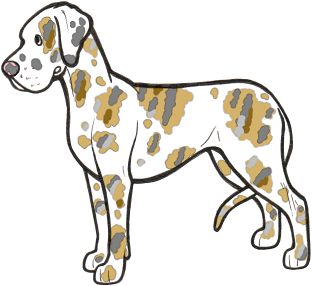
Blue brindle harlequin: dd/Hh/kbr-/Mm/SS
- Blue brindle harlequin mantle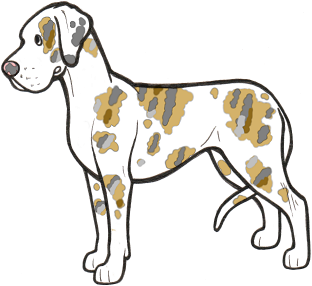
Blue brindle harlequin mantle: dd/Hh/kbr-/Mm/sisi
Please note that I'm assuming here that mantle Great Danes have the irish spotting gene (si). However, genetic testing has shown that not all mantle Danes do have this gene and some are actually pseudo-irish, which means their pattern comes from the piebald gene sp (they are piebald heterozygotes - see the White Spotting page for more info). This would add yet another pattern to our Great Dane list - piebald (or "plattenhunde"), which can occur on any colour. However I have decided not to include this pattern here as it is not accepted by all kennel clubs and will just complicate the case study even more!

Specialist Terms
Fawn - sable.
Merlikin/merlequin - white with merle patches (i.e. double merle) or irish-spotted merle.
Plattenhund - piebald. We won't be dealing with this variation here, but it is accepted by the FCI.
Fawnequin - harlequin with fawn patches.
Brindlequin - harlequin with brindle patches.
Mantle/Boston - irish spotted, which means white markings on the muzzle, legs, chest, neck and tail tip.
Porcelaine - any harlequin colour other than black. e.g. brindle harlequin, blue harlequin, fawn harlequin.

Breeding
We're going to look at a few different example breedings to get a better idea of how Great Dane genetics work. First we'll look at a couple of breedings from acceptable colours, then we'll see what happens when we cross unacceptable colours. The breedings will be:
- Fawn x mantle
- Brindle x harlequin mantle
- Blue x harlequin
- Fawn merle x blue brindle mantle
Remember that with all of these breedings, the results could be very different if both parents are carriers of a recessive gene. This means that unless you have a very good knowledge of the pedigree of each parent, it's hard (or even impossible) to accurately predict breeding results. The example breedings on this page assume that the genotypes of both parents are known. In real life, breeding the same colour combinations as we've looked at here may result in entirely different puppies! For example, our blue x harli litter below doesn't result in any blue puppies. But if the harli parent was Dd on the D locus, some of the puppies would be blue. And if both parents were brindle carriers (kbrK, rather than kbrk, which would allow them to express brindle), some of the puppies could be brindle.

Fawn X Mantle
 X
X
To make things nice and easy, let's say that neither of these dogs carries any hidden recessive genes. So the fawn is DD/hh/kk/mm/SS and the mantle is DD/hh/KK/mm/sisi. The D, H and M locii are the same in the two dogs, so we can ignore those, leaving us with kkSS x KKsisi.
Now let's do some Punnet squares. See the Breeding page if you don't know how these work.
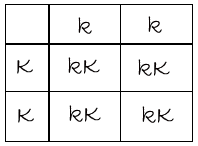
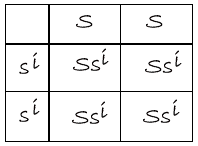
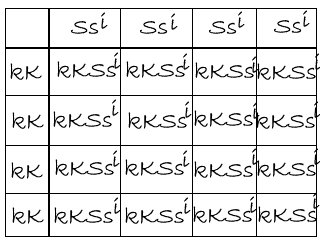
All of the puppies will have the genotype kKSsi, or DDhhkKmmSsi, to be precise. K (solid black) overrides k (effectively sable) and S (no white) overrides si (mantle). So the litter will be entirely solid black (with or without some minor white markings). They will, however, be carriers of sable and mantle, so could have puppies of these colours if bred to the right dogs.
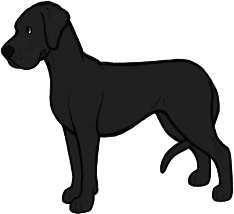

Brindle X Harlequin Mantle
 X
X
The brindle is DD/hh/kbrk/mm/SS and the harli mantle is DD/Hh/Kk/Mm/sisi. The D locus is the only one we can ignore here. The brindle carries k, which allows for sable, and so does the harli.
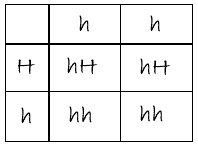
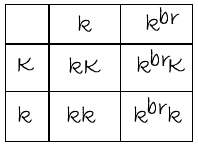
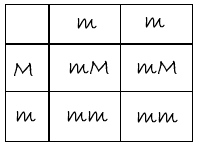

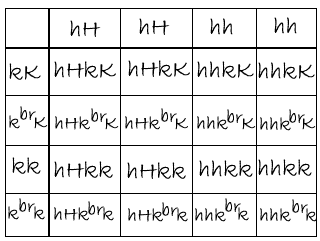
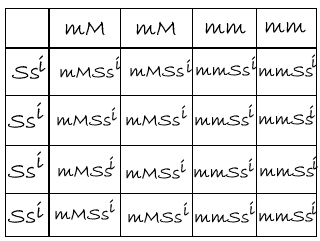
Now we hit a bit of a problem. If we try to combine these two Punnet squares, we would end up with one which is 16x16, and this is way too big to work with. Click here to see exactly how big it would be. Filling in something like that would be a nightmare, not to mention trying to work out the results and percentages afterwards!
So what we're going to do instead is get rid of some of the unnecessary repetitions in the two Punnet squares above. In the first one, you'll notice that we actually have 8 different genotypes (two of each). In the second we have just 2 genotypes (8 of each).

I won't go through each genotype individually, but we've ended up with: 2 harlis (hH/kK/mM/Ssi, hH/kbrK/mM/Ssi), 2 merles (hh/kK/mM/Ssi and hh/kbrK/mM/Ssi), 1 brindle harli (hH/kbrk/mM/Ssi),
1 brindle merle (hh/kbrk/mM/Ssi), 1 fawn harli (hH/kk/mM/Ssi), 1 fawn merle (hh/kk/mM/Ssi),
4 blacks (hH/kK/mm/Si, hh/kK/mm/Si, hH/kbrK/mm/Ssi and hh/kbrK/mm/Ssi), 2 fawns (hH/kk/mm/Ssi and hh/kk/mm/Ssi) and 2 brindles (hH/kbrk/mm/Ssi and hh/kbrk/mm/Ssi). Remember that any dog with the harlequin gene (H) needs the merle gene (M) too in order to express harlequin. So a harlequin
with no merle will just be a normal solid. And also remember that one K gene will override k and kbr.
None of the pups in this litter have irish spotting because only one parent had that gene to pass on, and it's recessive. They may, however, have some minor white markings.
My maths is rather rusty, but I believe that to find out the probability of getting each genotype or each colour, you have to multiply it by 2 and 8 (because of the cells we got rid of before), and then divide however necessary to get a percentage or a fraction. The overall
amount of cells in the original, huge Punnet square was 256. So the chances of getting a black are 64/256 (64 is 4 x 8 x 2). The chances of getting each particular genotype are 16/256 (1 x 8 x 2).
We can then reduce these fractions down (just keep dividing both the top and the bottom by 2). 64/256 reduces down to 32/128, then to 16/64, then to 8/32, 4/16, 2/8, 1/4. So the chances of getting a black are 1/4, or 25%. Of course,
we could have just worked this out from looking at the last Punnet square (if 4/16 cells give black puppies, we already have our fraction to work with), but I've
included the working out just in case you ever need it.
And finally, here are our pups:
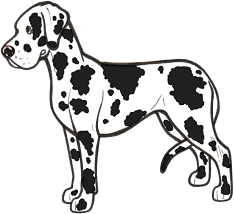

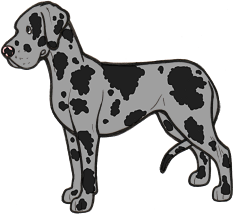

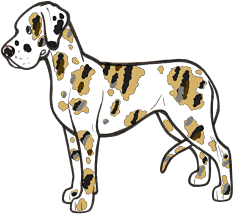
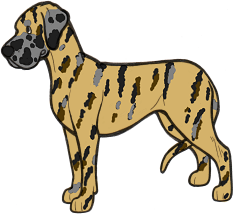
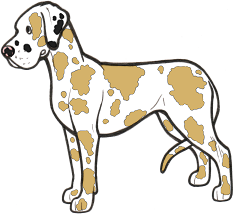
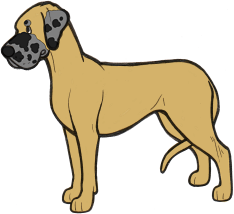




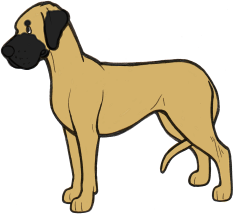

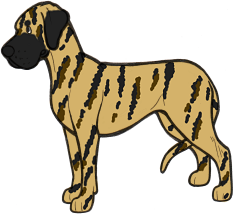

5/8ths of the litter are showable (the blacks, standard fawns and brindles only). The rest would be disqualified.

Blue X Harlequin
 X
X
The blue is dd/hh/KK/mm/SS and the harli is DD/Hh/KK/Mm/SS. We can ignore the K and S locii. We can also predict the D locus results without bothering to draw a Punnet square. If the blue parent can only give d and the harli parent can only give D, all the puppies will be Dd, so non-dilutes carrying dilute.


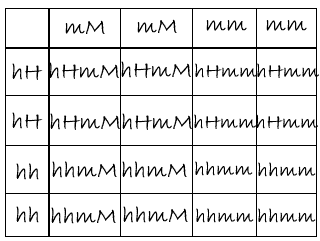
So we've got 4 hHmM dogs (which have one harlequin and one merle gene, so will be harlequin), 4 hhmM dogs (which have one merle gene and no harlequin, so will be merle), 4 hHmm dogs (which have one harlequin gene but no merle, so will be solid), and 4 hhmm dogs (which have no harlequin and no merle, so will also be solid). All of these will be black-pigmented because they're Dd.





Fawn Merle X Blue Brindle Mantle
 X
X
Finally, here's an example where neither parent is an accepted colour. The fawn merle is Dd/hh/kk/Mm/Ssi and the blue brindle mantle is dd/hh/kbrk/mm/sisi. We can ignore the H locus. The fawn merle, in this example, carries blue and irish spotting.
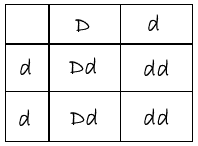
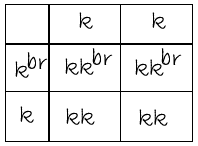
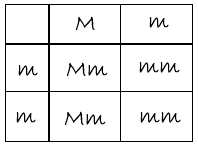
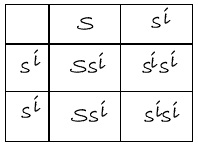
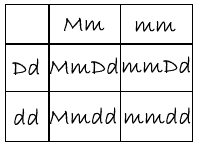
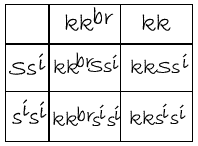
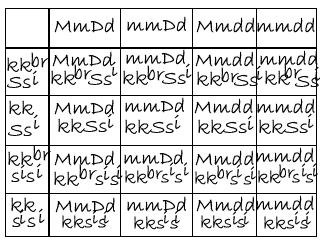
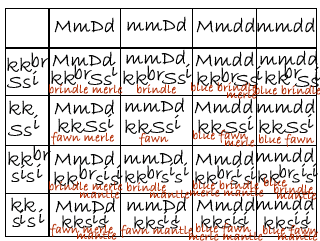


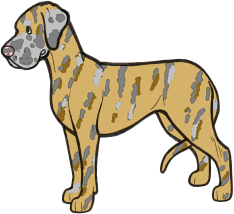
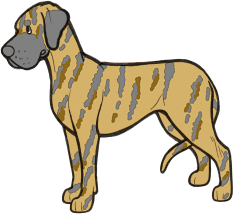


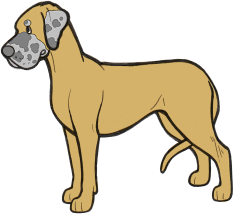
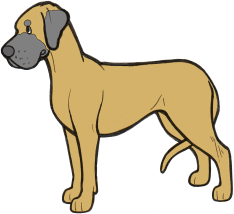
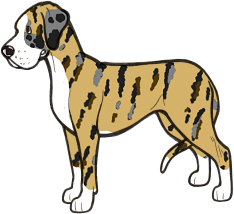
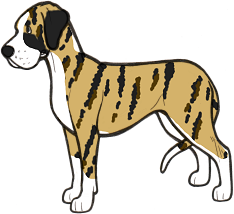
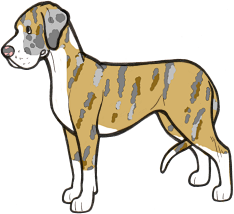
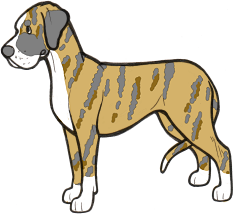
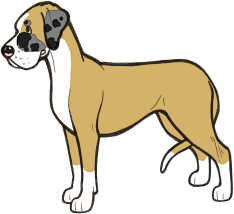
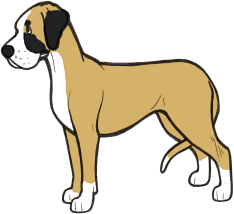
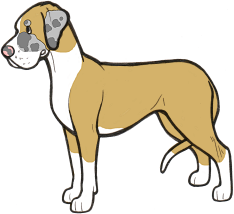
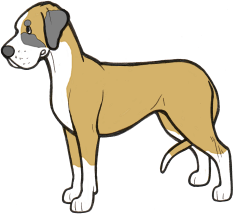
What a colourful litter! It's likely that no two pups will be the same colour, because there are 16 choices for genotypes and they are all equally likely and all produce a different colour/pattern. However, only 2/16, or 1/8 of the possible puppies will be showable (solid fawn and solid brindle).


** Please note that I am not a research scientist, and the information on this page comes from my own knowledge and observation of dogs, observational and testing data provided via e-mail by site visitors, any research papers linked on the page, and the information provided by Dr Sheila M. Schmutz on her excellent website http://homepage.usask.ca/~schmutz/dogcolors.html
For further genetics resources, see the Links page